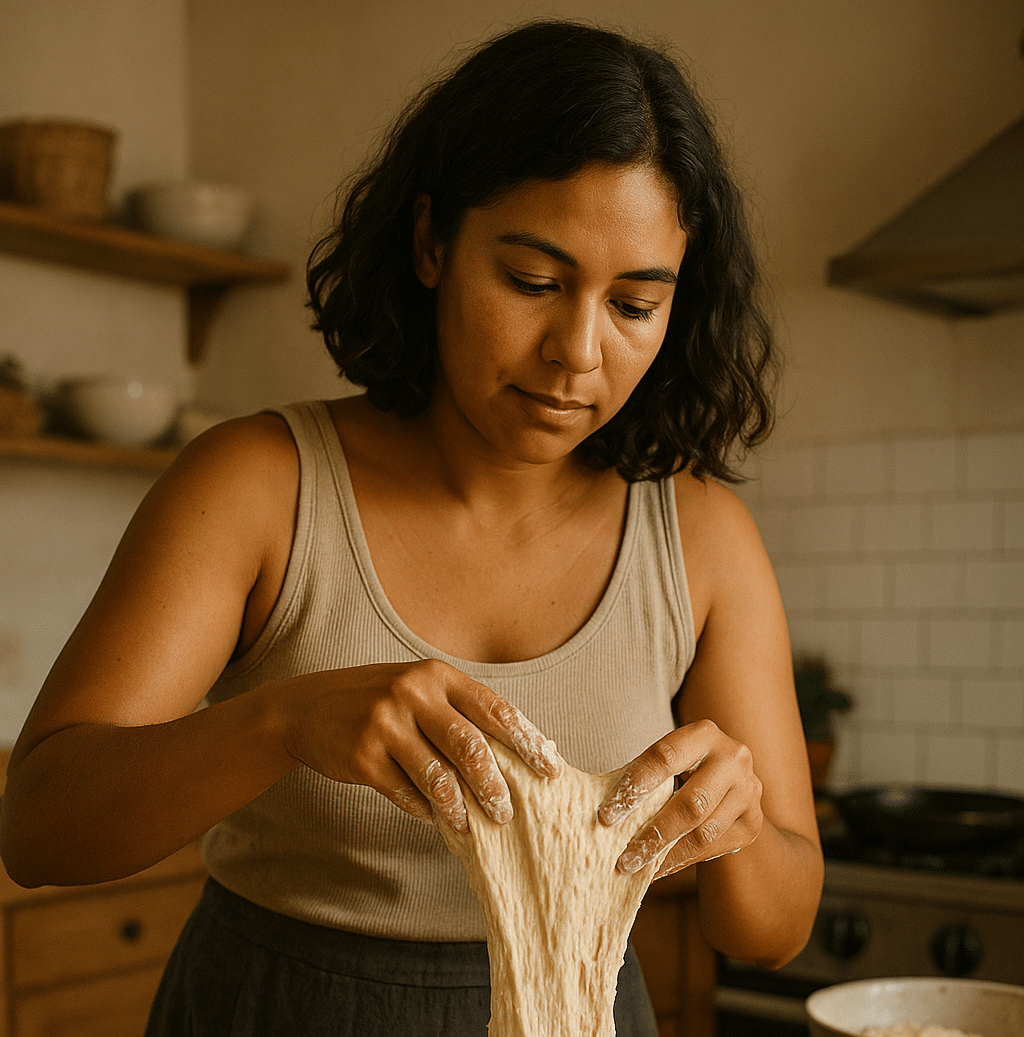f you’ve ever stared at your sourdough jar thinking, “What do I even do with all this discard?”, you’re not alone. Today, we’re turning that leftover starter into a chewy, golden, flavor-packed pizza crust that’s anything but wasteful. This article walks you through making the perfect discard pizza dough sourdough style—no need to feed or activate the starter. We’ll go over the story behind this dough, how to work with sticky textures, baking methods, and starter swaps. Plus, we’ll clear up common questions like whether you can use an active starter or how to cook it for the best crust.
Table of Contents
The Cozy Story Behind Discard Pizza Dough Sourdough
A Friday Night Tradition, Born From Discard
My journey with discard pizza dough sourdough started out of pure impatience. One Friday evening, my fed starter wasn’t ready, but the craving for homemade pizza hit hard. I looked at my jar of unfed sourdough discard—bubbling slightly, begging not to be tossed—and decided to take a chance. I mixed it with some warm water, flour, and yeast, hoping it would deliver. Spoiler alert: it did, and now this discard pizza dough sourdough recipe is part of our weekly pizza ritual.
There’s something magical about how discard—what most people consider waste—can still contribute so much flavor and depth. This isn’t just about making pizza dough; it’s about giving new life to what would’ve been tossed. The sourdough tang lingers in every bite, and the crust crisps up beautifully in a hot oven. That’s the beauty of discard pizza dough sourdough—it feels like a secret shortcut to something gourmet.
If you’ve ever made something unexpectedly delicious using scraps, you’ll get it. It’s like finding gold at the bottom of your starter jar. And if this resonates, you might also enjoy my guide on how to store sourdough starter between bakes or even ways to use discard for morning pancakes.
Why Sourdough Discard Works in Pizza Dough
Using sourdough discard in pizza dough gives you the best of both worlds: the quick rise of yeast and the complex flavor of sourdough. Because discard is unfed and slightly acidic, it adds a slight tang and tenderizes the dough naturally. This makes discard pizza dough sourdough not only practical but also tastier than traditional pizza bases.
Another benefit? This method reduces food waste. Instead of tossing that extra starter, you’re building it into something satisfying. If you’re still building your sourdough routine, check out my essential discard management tips and how to time your bakes for less stress.
In short: discard pizza dough sourdough isn’t just a clever use of leftovers—it’s your new go-to base for pizza nights that taste homemade, rustic, and just the right amount of tangy.
Mastering the Mix: How to Handle Discard Pizza Dough Sourdough
The Right Way to Mix Your Discard Pizza Dough Sourdough
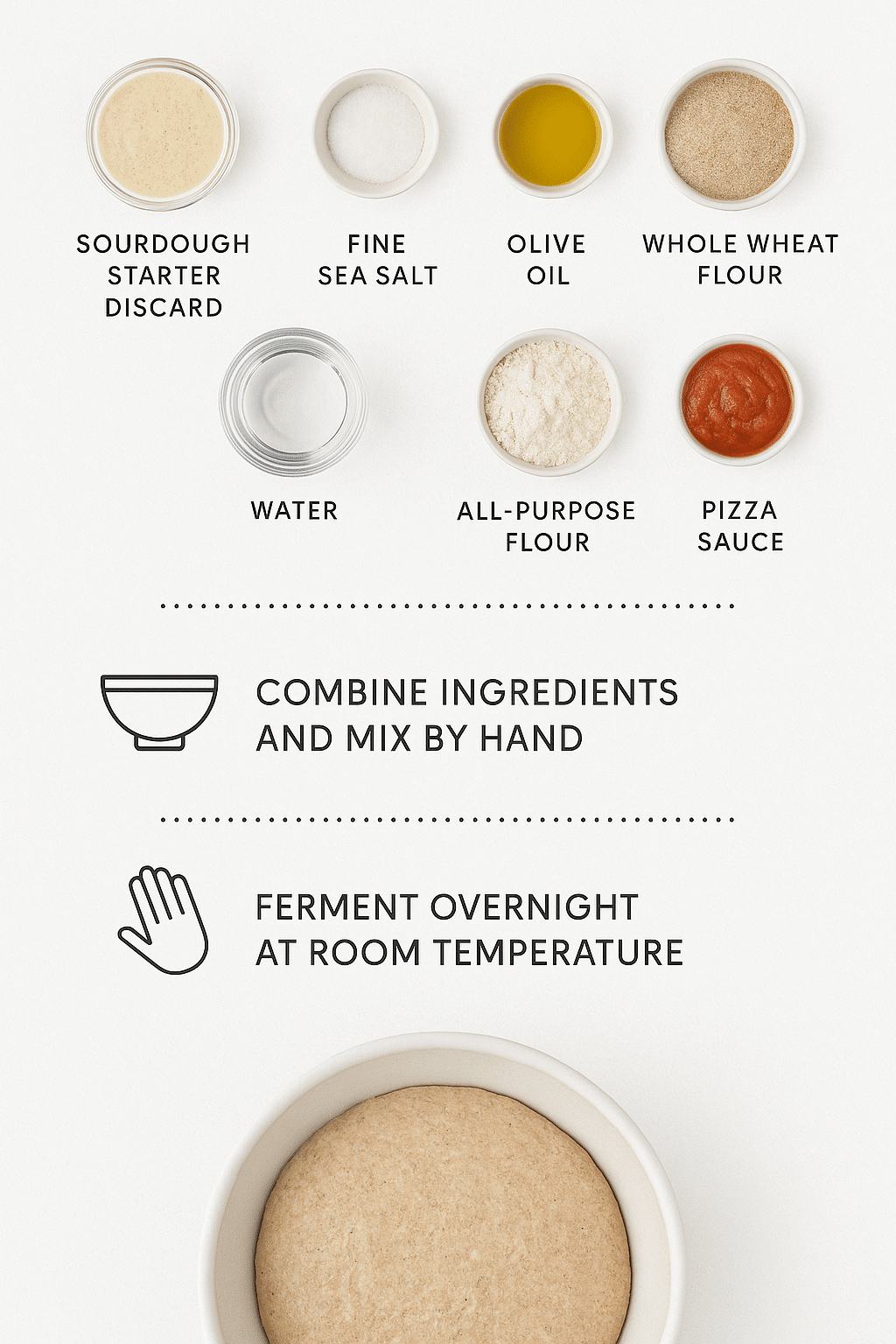
When it comes to mixing discard pizza dough sourdough, don’t overthink it. You’re not aiming for a traditional sourdough fermentation here—this dough is meant to be easy, reliable, and flavorful. The combination of unfed sourdough discard and instant dry yeast gives you a forgiving structure with a noticeable tang.
Start by whisking your bread flour, yeast, salt, and sugar in a large bowl. Next, stir in your sourdough discard, warm water, and olive oil. A wooden spoon works fine here—just mix until it forms a shaggy dough. At this point, it may look a little rough. That’s normal. Once it’s mixed, let it rest for about 5–10 minutes before kneading.
You can knead by hand or with a stand mixer for 5–6 minutes. The dough should feel soft and slightly tacky but not overly wet. If it clings too much, dust in just a tablespoon of flour at a time. No need to go overboard—it’s supposed to be slightly sticky. For a visual reference, see my sourdough bagels dough handling guide, which uses similar hydration.
This dough benefits from a long cold ferment (up to 24 hours in the fridge), which deepens flavor. But you can also let it rise at room temperature for 1–2 hours until doubled in size. Flexibility is key with discard pizza dough sourdough—another reason it’s a weeknight favorite in our house.
Working with Sticky Dough: Embrace It
Sticky dough intimidates a lot of new bakers, but here’s the truth: a slightly sticky dough often makes a better crust. The hydration in discard pizza dough sourdough is what gives it that gorgeous oven spring and chewy bite. If you try to make it too dry, you’ll lose that magic.
A few tips for handling it with ease:
- Oil your hands and bowl lightly. This keeps the dough from sticking too much during the knead and rise stages.
- Use a dough scraper to help lift and fold the dough, especially if working on a counter.
- Dust with semolina flour when shaping for a bit of added texture and less sticking. This is especially useful when preparing your peel or baking surface.
If your dough feels out of control, don’t panic. Let it rest a bit longer—it often relaxes into shape. Sticky doesn’t mean wrong. In fact, it usually means delicious.
Need help with dough timing or want to compare hydration tips? Check out this guide to sourdough hydration levels or my breakdown of sourdough boule shaping techniques.
By the time you’re ready to roll or stretch the dough, it should feel relaxed and stretchy—like a well-earned Friday night.
Cooking Your Discard Pizza Dough Sourdough to Golden Perfection
Oven Techniques for a Crisp, Chewy Crust
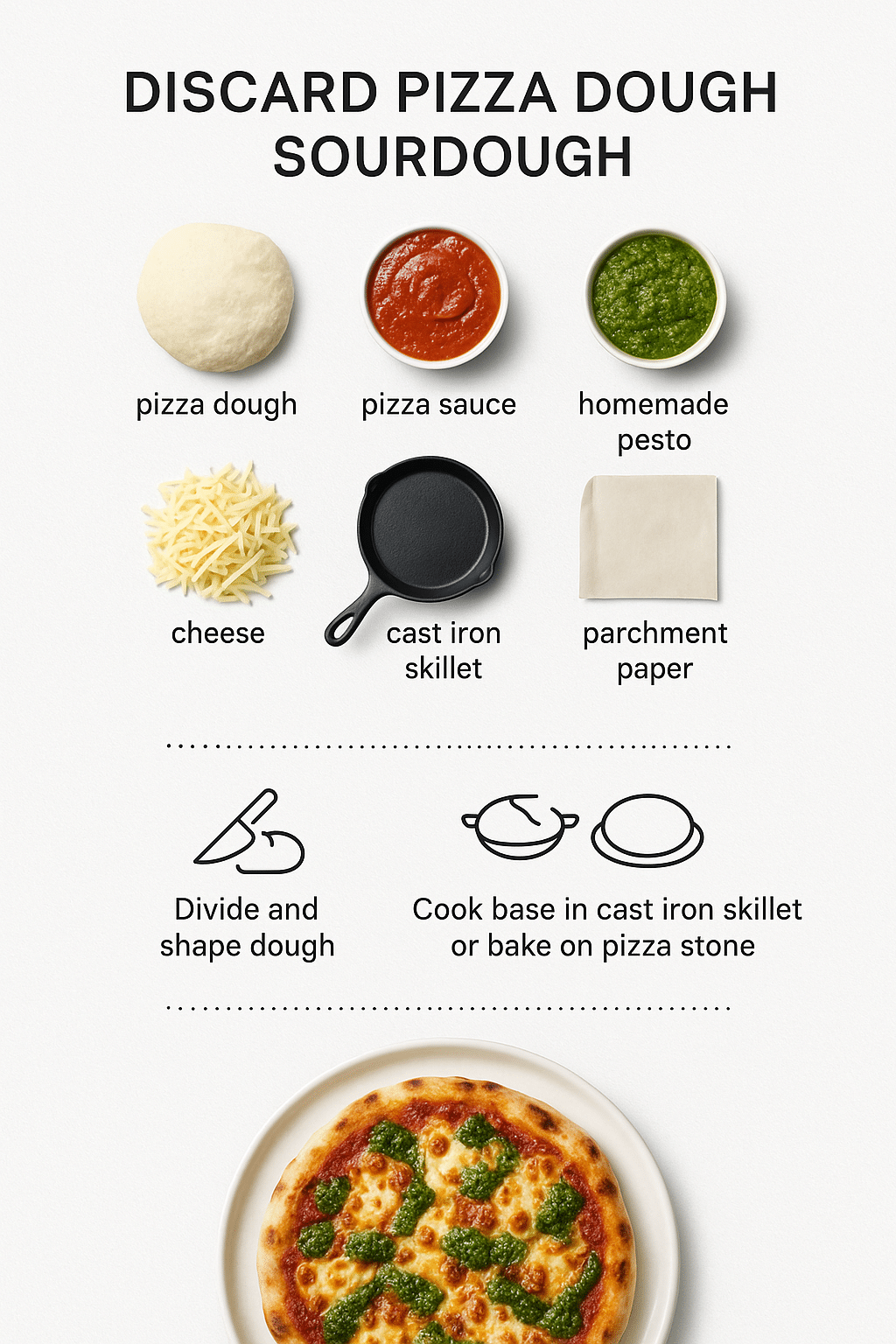
Once your discard pizza dough sourdough has risen, it’s time to bake. Getting that ideal chewy center with a crispy edge starts with high heat and a few prep tricks. Preheat your oven to 500°F (260°C) at least 45 minutes before baking—this step is crucial for oven spring.
If you have a pizza stone or steel, place it in the lower third of the oven to heat fully. If not, a preheated heavy-duty baking sheet works too. Roll or hand-stretch the dough onto parchment paper or a semolina-dusted peel for easy transfer.
Brush the dough lightly with olive oil and dock the center (poke it with a fork) to avoid bubbling if you’re doing a white pie or thin base. Otherwise, top it and bake as usual.
Bake your pizza for 7–10 minutes, rotating once halfway through. The crust should puff up and turn a deep golden brown. For a crispier base, finish the last minute or two on the bare stone or steel by sliding out the parchment.
Want to dive deeper into perfect crust techniques? I’ve detailed some of my favorite pizza oven tips and crisping methods in this sourdough flatbread recipe—a great alternative for smaller bakes.
Topping Ideas and Dough Versatility
Because discard pizza dough sourdough has so much built-in flavor, it pairs beautifully with both minimalist and bold toppings. A simple Margherita lets the sourdough tang shine, while bolder combos like caramelized onions and blue cheese bring out the depth.
You can even par-bake the crust for 5 minutes, freeze it, and top it later. This makes midweek pizza nights more doable—and that’s where this dough really shines. You’re making something that’s easy to prep in advance, yet feels handcrafted and full of character.
Want to try shaping it into calzones or sheet-pan focaccia-style pies? The dough handles it beautifully. I go into more alternative uses in my sourdough discard garlic knots guide if you’re in the mood for something snackable.
Whether you’re baking for the family or trying new topping styles solo, this dough gives you a reliable, flavorful base that’s miles beyond store-bought crust.
Active Starter vs. Discard: What’s the Difference in Pizza Dough?
Can You Use Active Sourdough Starter in Place of Discard?
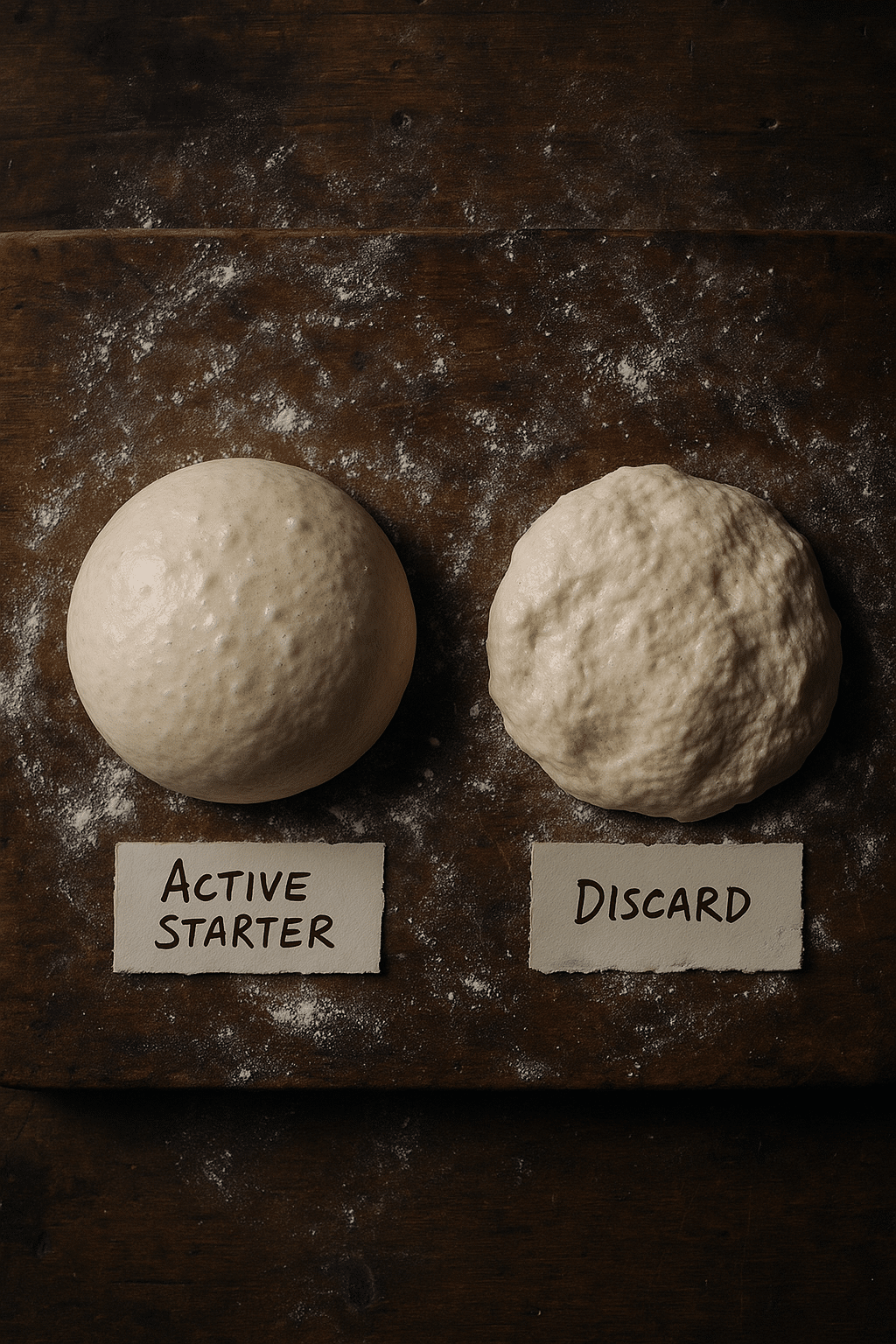
Here’s the question I hear most: “Can I use my active sourdough starter for this instead of discard?” The short answer is yes—but with a few important notes. While this recipe was developed specifically for discard pizza dough sourdough, you can absolutely swap in an active starter, especially if that’s what you have on hand.
Just remember, an active starter will add more lift on its own, which might require less commercial yeast or a shorter rise time. Your dough may puff slightly more and bake up a bit lighter, but the core flavor stays similar.
If you’re planning to use your active starter, reduce the added yeast by half. You can even do a long, cold ferment overnight using only the starter for rise. I explain this kind of timing in detail in my overnight sourdough pizza crust tutorial, which works great for weekend prep.
So yes—active starter works. But the beauty of this recipe is that it doesn’t require it. It’s designed to help you use up discard with zero guilt, zero waste, and full-on flavor.
How Flavor and Texture Change Between Discard and Active Starter
Using discard gives the dough more tang, especially if the discard is several days old and hasn’t been refreshed. It won’t rise on its own, which is why we use instant yeast in this recipe. Discard also adds tenderness—its acidity slightly weakens the gluten, which is why this crust is so pleasantly chewy.
Using an active sourdough starter, on the other hand, creates a more structured crumb and a milder tang. This can be ideal if you want a cleaner flavor profile or if you’re baking for folks who aren’t crazy about strong sour notes.
Want a full breakdown of the differences in starter behavior and how it impacts baked goods? I go deeper in my sourdough starter troubleshooting guide, especially helpful if your discard is behaving inconsistently.
In the end, both options work—so it really comes down to your schedule and your flavor preference. That’s part of what makes sourdough so special. Whether you use it fed or unfed, discard or active, it adapts.
Frequently Asked Questions About Discard Pizza Dough Sourdough
What is sourdough discard?
Sourdough discard is the portion of your starter you remove before feeding it. It’s unfed and not strong enough to leaven bread, but it still carries loads of flavor. In this recipe, discard adds depth and tang to the dough without needing a long fermentation. For more ideas, explore my favorite sourdough discard recipes here.
Why is my dough feeling sticky?
Sticky dough is normal, especially in high-hydration recipes like this one. The sourdough discard contributes to that softness. If it’s unmanageable, oil your hands or add a small amount of flour—just don’t overdo it. A little stickiness often leads to the best texture.
How should I cook the pizza once I have the dough?
After shaping and topping, bake your discard pizza dough sourdough on a hot pizza stone or steel at 500°F for 7–10 minutes. A preheated surface gives you that crisp, blistered bottom. For more cooking tips, check out my complete sourdough pizza baking guide.
Can I use active sourdough starter for this recipe?
Yes, but you’ll need to adjust. Reduce the added yeast and shorten the rise time. Active starter gives a bit more rise and a milder sour flavor. The recipe remains flexible depending on your schedule and taste preferences.
Conclusion: From Waste to Weeknight Hero
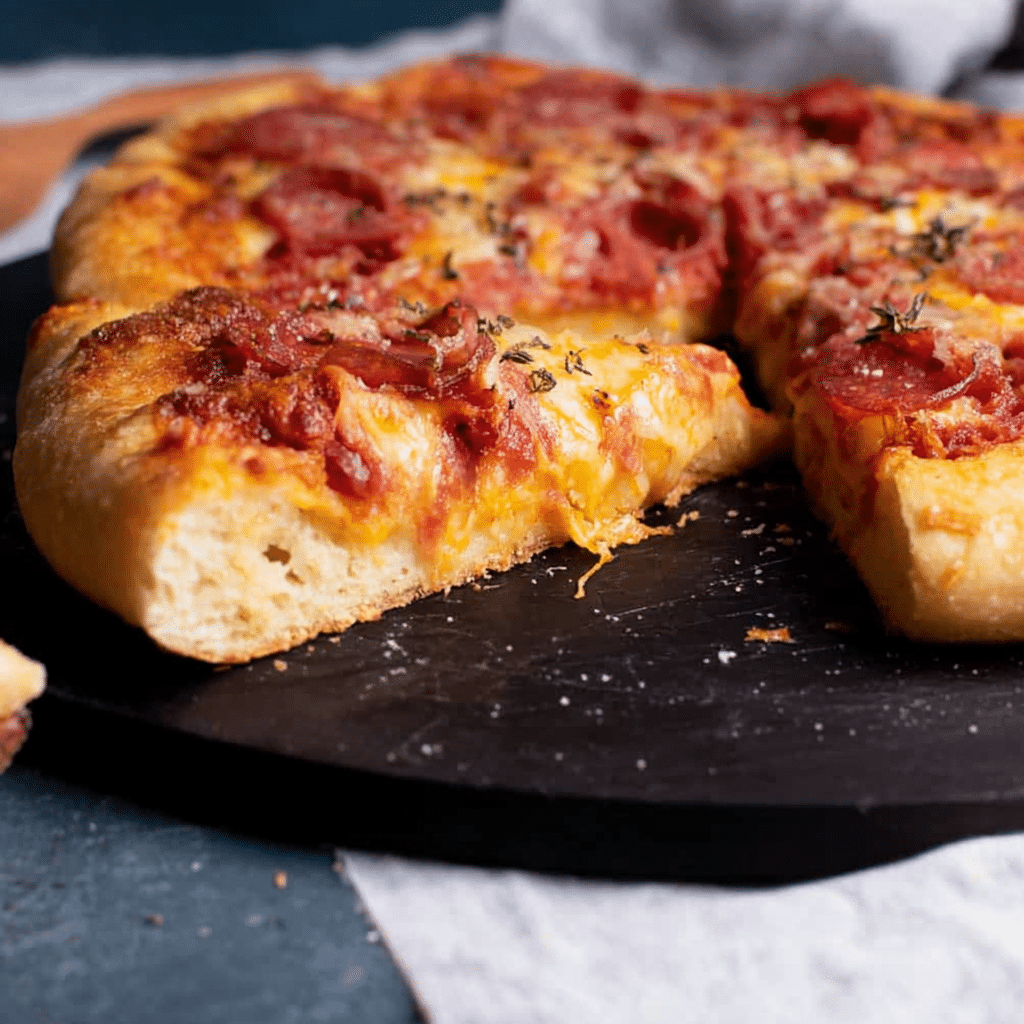
Turning your starter scraps into chewy, golden pizza crust is more than just a clever trick—it’s a way to build flavor, reduce waste, and make sourdough part of your everyday kitchen life. Whether you’re working with discard or starter, the result is always something deliciously real and homemade.
So next time you’re about to toss that discard, pause. There’s a bubbling pizza night just waiting to happen.

Discard Pizza Dough Sourdough: The Best Way to Use Starter Leftovers
- Total Time: 25 minutes
- Yield: 2 medium pizzas
Description
A flavorful, chewy pizza dough made using unfed sourdough discard. Easy, no-waste, and full of tangy character.
Ingredients
- 3 cups bread flour
- 1 ¼ teaspoons instant dry yeast
- 2 teaspoons kosher salt
- 1 teaspoon granulated sugar
- 200 grams (about ¾ cup) sourdough discard, unfed, at room temperature
- ¾ cup warm water
- 2 Tablespoons olive oil
- Semolina flour for dusting
Instructions
Whisk flour, yeast, salt, and sugar in a large bowl.
Stir in sourdough discard, warm water, and olive oil until a shaggy dough forms.
Let rest 10 minutes, then knead for 5–6 minutes until smooth and tacky.
Place in oiled bowl, cover, and rise 1–2 hours at room temperature or overnight in fridge.
Preheat oven to 500°F with pizza stone or steel inside.
Shape dough on semolina-dusted surface; top as desired.
Transfer to hot stone and bake 7–10 minutes until golden.
Slice and serve immediately.
Notes
For extra flavor, cold ferment the dough up to 24 hours.
Use olive oil or lightly wet hands to handle sticky dough.
- Prep Time: 15 mins
- Cook Time: 10 mins
- Category: Sourdough Discard Recipes
- Method: Baking
- Cuisine: Italian-American


